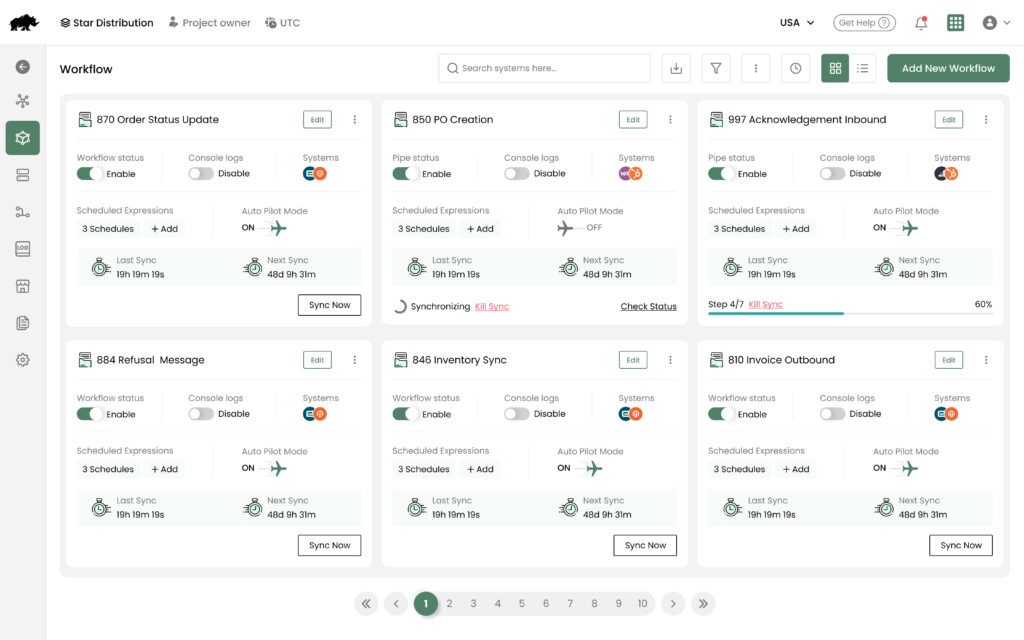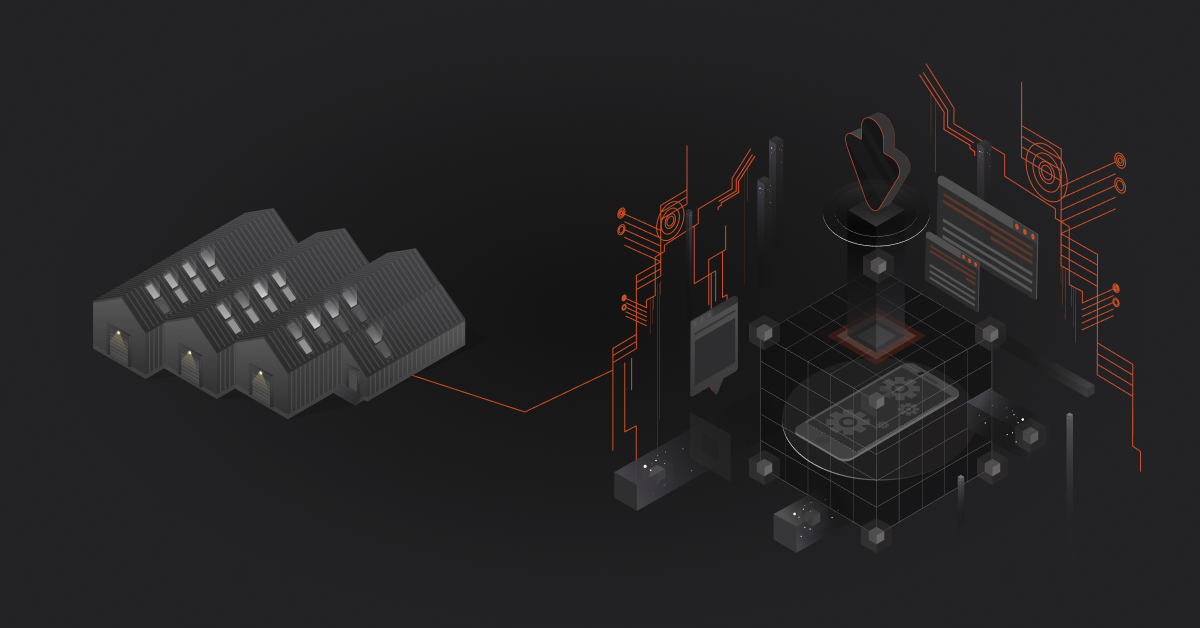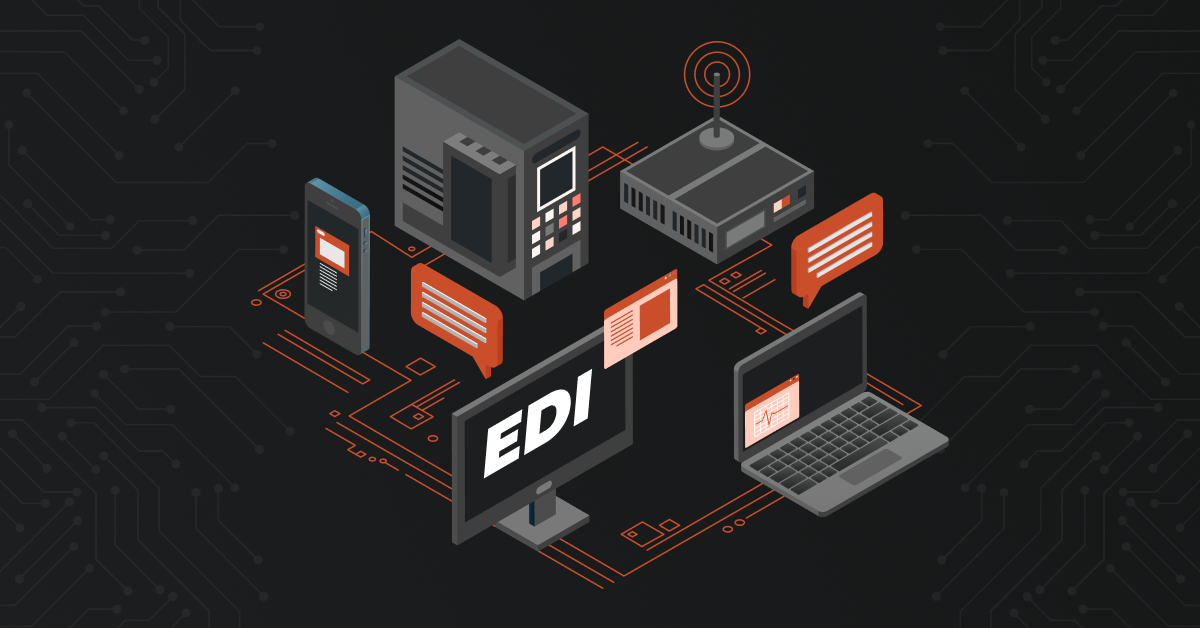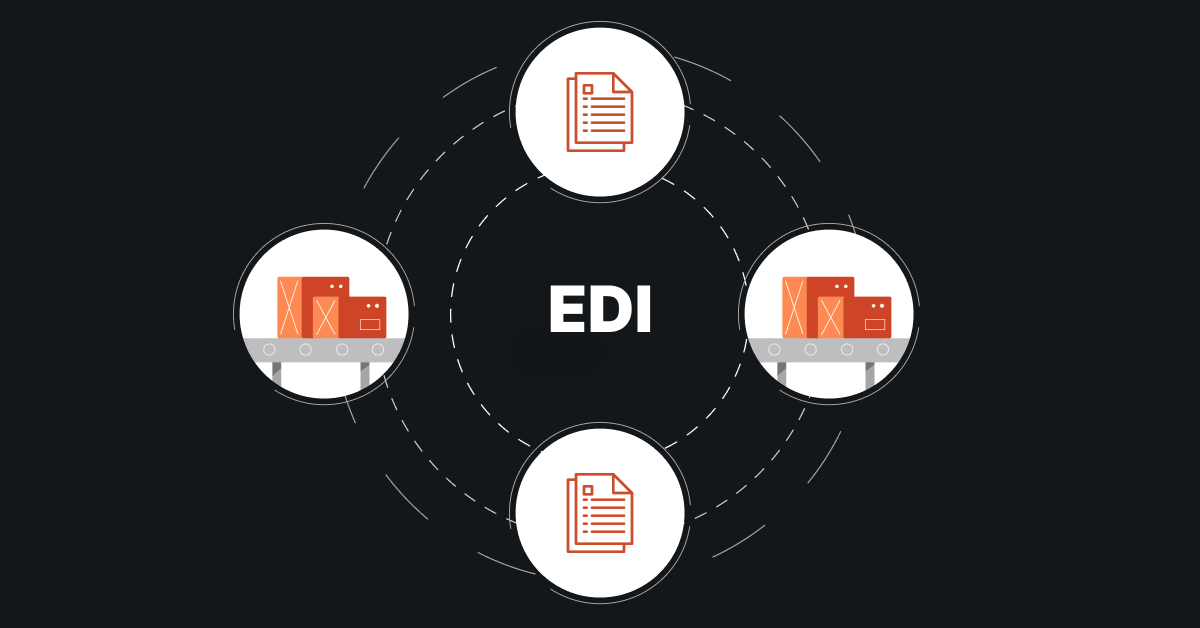Electronic Data Interchange (EDI) is a standard that governs the electronic exchange of business documents and data between organizations in the manufacturing industry. It replaces paper-based transactions and lets companies digitally send and receive documents like purchase orders and invoices, including advance shipment notifications: thus boosting efficiency, reducing errors, and speeding up transaction processing.
Types of EDI In Manufacturing
1. Direct EDI
It is also called point-to-point electronic data interchange. Direct EDI integration connects two trading partners to exchange EDI documents. This method uses standardized protocols and formats. In this, they use AS2, FTP, SFTP, and HTTP/S protocols.
Pros:
- Security: Direct connections can be highly secure, especially when using protocols like AS2.
- Speed: Direct integration is often faster. It doesn’t rely on intermediaries.
- Control: Offers greater control over the EDI environment and data exchange processes.
Cons:
- Complexity: Setting up and maintaining direct connections can be technically challenging.
- Cost: Higher initial investment in infrastructure and ongoing maintenance.
- Scalability: Not easily scalable when dealing with multiple trading partners.
2. EDI via Value-Added Networks (VANs)
A value-added network intermediates EDI transactions between trading partners. VANs offer a secure network for transmitting, storing, and retrieving EDI documents. Available Services Mailboxing, translating data, ensuring security, and handling compliance reports.
Pros:
- Ease of Use: Simplifies the complexity of EDI integration by handling network management.
- Security and Reliability: Offers robust security features and reliable uptime.
- Scalability: Easily accommodates additional trading partners.
Cons:
- Cost: Ongoing fees based on data volume or transaction counts.
- Dependency: Reliance on a third-party provider for critical business processes.
- Latency: Potential delays due to processing within the VAN.
Also see: EDI Integrations Explained [Steps, Types and Benefits]
3. Web EDI
Web EDI exchanges EDI documents through internet-based applications and web forms. Trading partners log into a portal to easily send and receive data, eliminating the need for complex EDI software.
Pros:
- Accessibility: Requires only a web browser and internet connection.
- Cost-effective: Lower upfront costs; ideal for small businesses with limited resources.
- Ease of Implementation: Minimal technical setup required.
Cons:
- Manual processes: Data entry can be manual, increasing the risk of errors.
- Limited Automation: Less suitable for high-volume transactions.
- Functionality Constraints: This may lack advanced features found in full-scale EDI systems.
4. EDI via AS2 (Applicability Statement 2)
AS2 transmits EDI documents securely over the Internet. It allows direct, point-to-point communication with encryption and digital certificates.
Pros:
- Security: Strong encryption and authentication methods.
- Cost savings: Eliminates the need for VANs, reducing ongoing costs.
- Real-Time Processing: Supports immediate data exchange.
Cons:
- Technical complexity: Requires expertise to set up and manage.
- Maintenance: Ongoing management of certificates and security protocols.
- Compatibility: Both trading partners must support AS2.
5. EDI via FTP/SFTP over VPN
Uses File Transfer Protocol (FTP) or Secure File Transfer Protocol (SFTP) over a Virtual Private Network (VPN) to securely exchange EDI documents.
Pros:
- Security: VPN adds an extra layer of security over standard FTP/SFTP.
- Flexibility: Can handle various file types and sizes.
- Cost-effective: Lower operational costs compared to VANs.
Cons:
- Setup Complexity: VPN configuration can be complex.
- Maintenance: Requires ongoing management of VPN connections.
- Reliability: Potential for connectivity issues affecting data transmission.
6. EDI via APIs (Application Programming Interfaces)
APIs let apps communicate directly. They enable real-time data exchange and integration with internal systems, and can be a conduit for EDI exchange.
Pros:
- Real-Time Data Exchange: Immediate synchronization between systems.
- Flexibility: Supports modern data formats like JSON and XML.
- Integration: Easily connects with cloud-based applications and services.
Cons:
- Standardization: Uniform standards prevent compatibility issues.
- Security Concerns: Secure APIs to prevent unauthorized access.
- Technical expertise: Skilled developers are needed for implementation and maintenance.
7. Hybrid EDI Solutions
Combines various EDI integration methods to meet business needs. A company might use direct EDI with major partners and web EDI with smaller ones.
Pros:
- Customization: Tailors integration approaches to specific partner requirements.
- Flexibility: Allows gradual adoption of more advanced EDI methods.
- Cost management: Optimizes investment by using cost-effective solutions where appropriate.
Cons:
- Complex Management: Multiple systems can increase administrative overhead.
- Inconsistency: Varying levels of automation and capabilities across different methods.
- Training Requirements: Staff may need to learn multiple systems.
8. Managed EDI Services
Outsource EDI integration to a third-party provider. They will manage the infrastructure, mappings, and partners.
Pros:
- Expertise: Access to experienced professionals without in-house hiring.
- Resource Allocation: Frees up internal resources for other strategic initiatives.
- Scalability: Providers can quickly adapt to changing business needs.
Cons:
- Cost: Service fees can accumulate over time.
- Control: Less direct oversight of EDI processes.
- Dependency: Reliance on the provider’s performance and stability.

9. Cloud-Based EDI
Hosts EDI services on cloud computing platforms for scalability and internet accessibility.
Pros:
- Scalability: Adjusts easily to changing transaction volumes.
- Cost-efficient: Lowers hardware and software capital expenses.
- Accessibility: Access EDI services from anywhere with internet.
Cons:
- Security: Data privacy and compliance concerns in the cloud.
- Connectivity: It relies on internet availability and bandwidth.
- Vendor Lock-In: Potential challenges if switching providers.
Common EDI Documents in Manufacturing
Here are some of the more common transaction codes in the manufacturing sector for EDI documents:
Purchase Orders (EDI 850)
Starts the buying process by specifying products, quantities, and prices. The benefits are that it speeds up order placement and minimizes manual entry errors.
Invoices (EDI 810)
Request payment for shipped goods or provided services. The benefits are accelerating billing and enhanced financial record accuracy.
Advanced Shipping Notices (EDI 856)
Notifies the receiver of pending shipments with details on contents and delivery information. They help recipients prepare for incoming goods and speed up order fulfillment.
Inventory Inquiry/Advice (EDI 846)
Notifies the receiver of pending shipments with detailed information on contents and delivery. It helps recipients prepare for incoming goods. It also streamlines receiving processes.
Functional Acknowledgment (EDI 997)
Confirms receipt and status of EDI transactions. The benefits are that it guarantees reliable communication and quickly identifies issues. It also enhances customer support.
Others
Request for Quotation (EDI 840) Seeks pricing and terms for potential orders. Product Activity Data (EDI 852) shares sales and inventory data to improve forecasting. Shipping Schedule (EDI 862) Details shipping requirements and schedules.
Importance of EDI in Manufacturing
Streamlined Supply Chain Operations
- Efficient communication: EDI enables real-time communication among manufacturers, suppliers, distributors, and retailers. This efficiency minimizes lead times and increases market response. This integration of EDI supports better visibility and collaboration among supply chain partners.
- Automated Transactions: Automating the exchange of documents, like purchase orders and invoices, cuts human interaction. This reduces errors and speeds up operations.
Cost Reduction
- Lower admin costs: Going paperless cuts printing, shipping, and storage costs.
- Reduced labor costs: Automation eliminates the need for data entry, allowing employees to focus on more valuable, strategic tasks.
Improved Data Accuracy
- Error Minimization: Automated data interchange reduces manual entry errors. It leads to more accurate, reliable information.
- Consistency: EDI transaction sets ensure all parties see information the same. This reduces misunderstandings and disputes.
Accelerated Business Cycles
- Faster Transaction Processing: EDI speeds up order processing and business document processing. It lowers the cycle times for orders, deliveries, and payments.
- Better customer service: Faster responses boost satisfaction. This can increase loyalty and repeat business.
Strengthened Trading Partner Relationships
- Better Collaboration: EDI builds trust by enabling accurate data exchange. It improves relationships with business-to-business (B2B) supply chain partners.
- Compliance with partner requirements: Many large retailers and key suppliers require EDI compliance. It is vital for maintaining and growing business ties.
Enhanced Inventory Management
- Real-Time Updates: EDI offers real-time quality control over inventory levels. This enables just-in-time (JIT) manufacturing and lowers carrying costs.
- Demand forecasts: Better data flow allows for more accurate forecasts. This avoids overstocking or stockouts.
Regulatory Compliance
- Adherence to Standards: EDI helps manufacturers meet industry regulations. It keeps accurate records and audit trails.
- Data Security: Secure EDI transactions protect sensitive data. They help meet data protection laws, like GDPR.
Global Trade Facilitation
- International Standards: EDI technology employs global standards. This makes it easier to do business with foreign business partners by removing language and format barriers.
- Customs Compliance: Automated document interchange eases customs and trade compliance.
Key Challenges With EDI In Manufacturing
High Implementation Costs
- Infrastructure Investment: An EDI system can have high setup costs for hardware, software, and networks.
- Customization Expenses: Tailoring EDI solutions to specific business processes can raise costs.
- Return on Investment (ROI): Small to medium-sized manufacturers may struggle to justify investments.
Complexity of Integration
- System Compatibility: Integrating EDI with ERP (Enterprise Resource Planning), CRM, or SCM systems can be complex and time-consuming.
- Data Mapping: Data mapping aligns data formats and fields between internal systems and trading partners’ systems.
- Technical expertise: A lack of in-house skills can hinder integration. It may lead to a reliance on external consultants.
Compatibility Issues with Trading Partners
- Diverse Standards: Trading partners may use different EDI standards (e.g., ANSI X12, EDIFACT). This can cause compatibility issues.
- Protocol Discrepancies: Variations in communication protocols can complicate data exchange.
- Partner Readiness: Some partners may lack EDI capabilities. This may require alternative communication methods or extra investments.
Data Security Concerns
- Sensitive Information: EDI transactions often involve confidential and sensitive information. It must be protected from unauthorized access.
- Cyber Threats: If not secured, EDI systems can be hacked. This can cause data breaches and financial losses.
Maintenance and Updates
- System Upgrades: Regular updates are needed to keep the system fast and secure. But they can be resource-intensive.
- Downtime Risks: Updates may cause system downtime. This could hurt business operations and revenue.
Training and Change Management
- Employee Resistance: Staff may resist changes due to fear of automation and new systems. They may also need to be trained to use new tools.
- Cultural Shift: Moving from manual processes to automated systems requires a major change in culture and mindset.
Scalability Issues
- Performance Bottlenecks: Poor infrastructure can slow processing and delay. This hurts manufacturing operations and supply chain efficiency.
- Cost Implications: Scaling up may require a big investment in infrastructure and licensing fees.
Limited Flexibility
- Rigid Standards: strict EDI standards can limit flexibility in data formats and processes. This makes it hard to meet unique business needs.
- Innovation Barriers: EDI implementations may not adapt to new technologies or business models. This could hinder innovation.
EDI Integration for Manufacturers & Distributors with DCKAP Integrator
DCKAP Integrator is a secure, scalable, and robust EDI solution for manufacturing. It follows industry best practices. It tackles common challenges: high costs, complex integration, data security, and scalability.
Key Benefits of Using DCKAP Integrator for EDI in Manufacturing
- Streamlined Integration: It simplifies connecting EDI with internal systems. It cuts complexity and implementation time.
- EDI and Integration: Allows for the smooth exchange of documents, as well as syncing critical data to tools like your ERP
- Improved Collaboration: It enables better communication and data exchange with trading partners. This boosts supply chain efficiency.
- Cost Savings: Lowers operational costs by automating processes and reducing manual efforts.
- Scalability and Flexibility: Adapts to your growth and changing specific needs. It requires no major extra investment.
- Real-Time Insights: Provides valuable analytics and monitoring tools to support informed decision-making.
Conclusion
EDI transforms manufacturing. EDI can streamline supply chains, improve inventory management, and enhance procurement processes. It can also strengthen trading partner relationships. But it has challenges. These include high costs, complex integration, compatibility issues, and security concerns.
The DCKAP Integrator simplifies EDI integration, overcoming obstacles effectively. It connects systems, automates data exchanges, and synchronizes information. It also enables custom workflows for specific business needs. The DCKAP Integrator boosts security and collaboration. It is also scalable and flexible. This lets manufacturers fully harness EDI benefits.
By using EDI and the DCKAP Integrator, manufacturers can better adhere to best practices and improve efficiency and competitiveness. Speak to our integration experts to see how you can shape your EDI and integration strategy.
FAQs
How does EDI impact supplier relationship management in manufacturing?
EDI improves supplier relationship management. It enables efficient, transparent communication between manufacturers and suppliers. Automating the exchange of critical documents, like purchase orders and invoices, reduces errors.
It prevents misunderstandings that can strain relationships. It allows real-time data sharing. This helps both parties synchronize operations, optimize inventory, and respond quickly to demand changes. Collaboration builds trust. It improves reliability and partnerships. This creates a strong, efficient supply chain.
How does EDI support lean manufacturing principles?
EDI streamlines processes and eliminates waste, aligning closely with lean manufacturing. It automates information exchange, cutting down on manual data entry and related errors. This automation speeds up processing and improves workflows.
EDI shows inventory and production schedules in real-time. It supports just-in-time (JIT) manufacturing and cuts excess inventory. EDI improves communication with suppliers and customers.
It aligns production with demand and reduces overproduction and wasted resources. EDI and lean principles create cost savings, enhance quality, and boost customer satisfaction.
What role does EDI play in demand forecasting and production planning?
EDI enhances demand forecasting and production planning with timely, accurate data exchange. Manufacturers get real-time sales orders and inventory levels from retailers and distributors.
This lets them analyze trends and predict future demand. This information adjusts production schedules and optimizes resources. It cuts the risk of overproduction and stockouts. EDI boosts collaboration with suppliers.
What are the differences between EDI and other forms of data exchange, such as APIs, in manufacturing?
EDI and APIs enable data exchange but differ in approach and use cases. EDI standardizes batch processing of business documents using formats like ANSI X12 or EDIFACT. It suits high-volume transactions and is widely used in traditional supply chain operations.
APIs enable real-time, on-demand data exchange and support formats like JSON and XML. EDI excels at standard transactions. APIs are better for dynamic interactions and modern web services.
Manufacturers can use EDI for core supply chain processes. They can use APIs for real-time data. This will create a complete integration solution.
Contents




